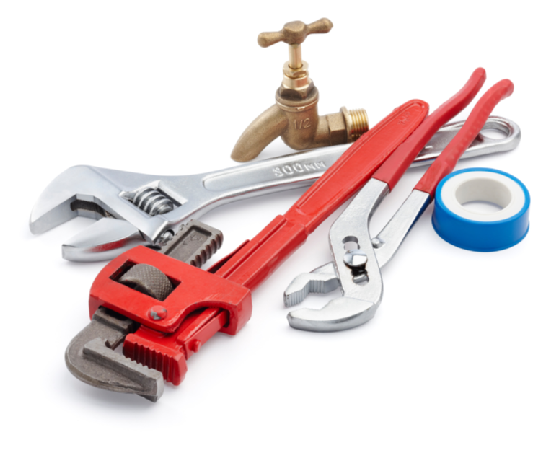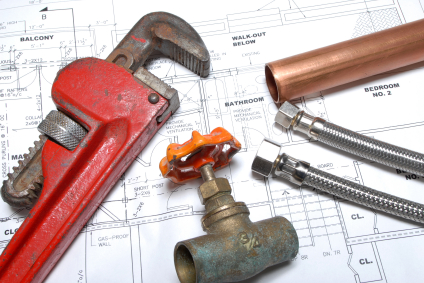Plumbers, Pipelayers, Pipefitters, and Steamfitters
New construction
Renovation
Plumber
Plumbing Equipment
Which tools and equipment do they require?
Adapters, Thread
Air Boosters
Air Bypass Subs
Air Compressors
Air Hammers
Air Hose & Fittings
Air Hose Safety Cable - Whip Socks
Air Hose Safety Cables
Air-Lube ES
Air Perforators
Alignment Clamps, Casing
Aluminum Clipboards
Anti-Freeze/Line Flush
AP Plus ES
Atlas Copco Products
Atlas Copco Top Hammer Products
Automatic Oilers - Electric
Automatic Oilers - Pneumatic
Auxiliary Tools - Top Hammer
Back Hammers
Back Reamer and Lift Tubes
Bags, Sample
Bails, Lifting
Baker Style Floats
Bench and Production Drilling
Beveling Machines, Pipe
Bio-Cut Plus
Bit Lubricants
Bit Sharpeners
Bit Sharpening, Grinding Stones
Bits, Claw
Bits, Drag
Bist, PDC
Bits, Reverse Circulation
Bits, Tricone
Bits, Hammer
Bits, Hole Openers
Blasthole Drills
Blow Tubes
Boosters
Borehole Cameras | |
Brass Pipe Fittings |

|
Breakers - Hand
Breakout Tongs, Hydraulic
Bridles, Lifting
Brushes, Pipe Dope
Buffers
Bulrock Overburden Systems
Bulroc Products
Button Sharpeners
Bypass Subs
Cables, Safety, Air Hose - Whip Sock
Cables, Safety, Air Hose
Cameras
Carbide Bit Sharpeners
Carbide Tricone Bits | |
Cast Iron Pipe Fittings |

|
Casing
Casing Advancement, Under Reamers
Casing Alignment Clamps
Casing Cameras
Casing Cutters
Casing Drive Shoes
Casing Drivers
Casing Elevators
Casing Elevators - PVC
Casing Extractors
Casing Jacks
Casing Lifting Bridles
Casing Pullers, Hydraulic
Casing Perforators
Casing Pullers, PVC
Casing Spinners
Casing Torch Guides
Center Recovery Drill Bits
Center Recovery Drill Pipe
Center Recovery Hammers
Centro Drilling System, Stratex (Overburden)
Chain Wrenches
Chisels, Rock
Clamps, Casing Alignment
Clamps, Well Pipe
Claw Bits
Clipboards, Aluminum
Cluster Drills
Collars, Drill
Compressed Air Boosters
Compressors
Compressor Oil
Construction Equipment, Hydraulic, Handheld
Coolant
COPROD
Core Drills, Hydraulic, Handheld
Core Tools
Cut-off Saws, Hydraulic, Handheld
Cutting Machines, Pipe
Cuttings Diverters
Cyclones
DD 2000
DD 605L
DD 955
DD Bit-Cool
DD Foam 1560
DD Xpand
Decking, Portable
Depth Sounders
D.H.F. (Diesel Hammer Fuel)
Diamond Rod Grease
Directional Drilling
Diverter Boxes
Diverter Boxes - Under Table
Dope Brushes
Dope, Pipe
Down the Hole Drilling (Secoroc)
Down Hole Cameras
Drag Bits
Drain Pumps, Hydraulic | |
|
Drain Cleaning Machines |
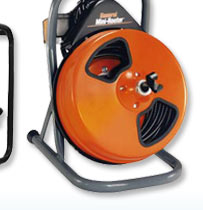
| |
|
Drifting and Tunneling Products | |
Drills |

|
Drill Bit Sharpeners
Drill Bits, Reverse Circulation
Drill Bits
Drills, Cluster
Drill Collars
Drills - Hand
Drill Hole Plugs
Drill Pipe
Drill Pipe Chain Tongs
Drill Pipe Extractor Hammers
Drill Pipe Lifting Plugs and Bails
Drill Pipe Spinners
Drill Pipe Stabilizers
Drill Pipe Thread Protectors
Drill Pipe, Reverse Circulation
Drills, Power Pole
Drilling, Directional
Drilling Gloves
Drilling Oil
Drilling Systems
Drive Shoes
Drivesr, Casing
Drop-off Ring Drilling System (Overburden)
DTH Casing Cutters
DTH Hammers/Drills
DTH Shock Absorbers
Dual Wall Pipe
Dura Deck
Dust Collectors
Dust Control Agent ES
Eccentric Drilling System (Overburden)
Electric Oilers
Elevators, Casing
Elevators, PVC Casing
Elevators, Sockerod
Engine Oil
Environmental Liquid Holding Tanks
Environmental Products
Environmentally Safe Dust Control Agent
Environmentally Safe Gear Oil
Environmentally Safe Hammer Oil
Environmentally Safe Hydraulic Fluid
Environmentally Safe Line Shaft Turbine Fluid
Environmentally Safe Lubricant
Environmentally Safe Rust Inhibitor
Environmentally Safe Rust Prevention
Environmentally Safe Wire Rope Lubricant
ES Rod Grease
Estwing Products
Exhaust Tubes
Exploration Products
Extractor Hammers
Extractors, Casing
EZ Lube - (high tech) Hammer Lube
| |
Fasteners |
What is a Fastener?

Fasteners:Here are some of the more common fasteners you can use:
Anchors (911)
Bolts (27,704)
Hardware (5,168)
Nails (154)
Nuts (4,540)
Pins (4,213)
Retaining Rings and Clips (554)
Riveting & Self-Clinching Products (2,247)
Rod (8,817)
Screws (21,702)
Security Fasteners (544)
Set Screws (3,566)
Sockets (11,164)
Strut, Clamps, and Hangers (970)
Thread Repair (657)
Washers (3,449)
Nails
They're the easiest way to put two pieces of wood together.
Screws
With more holding power than nails, and greater ease in removing, screws are an excellent way to fasten.
Bolts
These fasteners use nuts and washers as an anchor, helping form a stronger bond.
Clamps
When you need to hold things together for a short time, a clamp is just the thing.
Glues
Adhesives can attach two materials chemically, either bonding on their own or as an aide to another kind of fastener.
http://www.instockfasteners.com/Services/Index.asp
|
Field Logs
Fittings & Hoses
Fishing Magnets
Flagging Hi-Vis
Flange Wrenches
Float Subs
Float Valves
Foamer ES
Form-A-Core
Forms Holders
Foot Valves
| |
Galvanized Pipe Fittings |
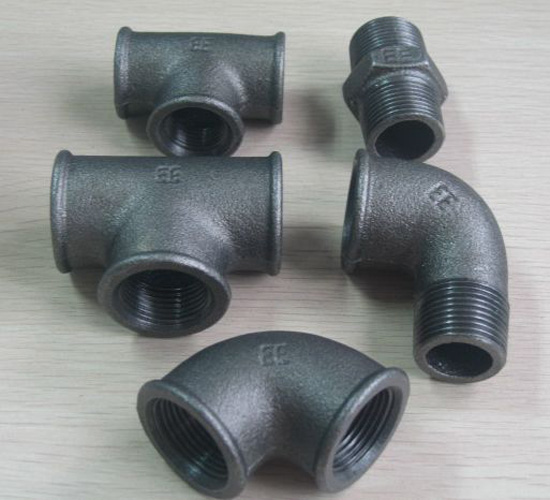
|
G-ROD Grease #800
Gas Powered Drills / Breakers
Gear Oil ES
Generators
Gloves
Gravel Packers
Grease, Rod
Greenland Products (GreenPlus)
Grinding Equipment
Grinding Equipment (Secoroc)
Grinding Stones
Guides, Torch, Casing
Hammer Drill Bits
Hammer Lube - EZ Lube (high tech)
Hammer Oilers - Electric
Hammer Oilesr - Pneumatic
Hammers, Extractor
Hammers, Reverse Circulation
Hammers
Hammers, Hand
Hand Drills / Breakers / Hammers
Handheld Bit Sharpeners
Handheld Construction Equipment, Hydraulic
High-Pressure Hose Restraints - Whip Socks
Hi-Tech 100-50
Hole Openers
Hole Plugs
Hoses & Fittings
Hurricane Boosters
Hydraulic Breakout Tongs
Hydraulic Casing Pullers
Hydraulic Construction Equipment, Handheld
Hydraulic Core Drills, Handheld
Hydraulic Cut-off Saws, Handheld
Hydraulic Drain Pumps
Hydraulic Fluid ES
Hydraulic Post Equipment
Hydraulic Power Packs
Hydrocyclone Subs
Hydro Jaw Breakout Tongs
Inline Oilers - Electric
Inline Oilesr - Pneumatic
Integral Equipment
Internal Casing Cutters | |
Irrigation |
Drip irrigation
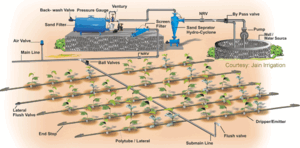
Pipes & Fittings

Sprinkler Timers
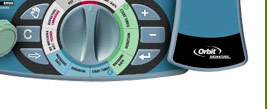
Sprinkler Heads

|
Jacks, Casing
Jack Hammers
Jet Subs
Kopr-Kote Thread Grease
Kwik-Klamps
Kwik-ZIP Pipe Centralization System
Large Diameter Drills
L.C.M. Pill (Lost Circulation Material)
Level TROLL Products
Lift Tubes
Lifting Bridles
Lifting Plugs and Bails
Line Flush/Anti-Freeze ES
Line Shaft Turbine Fluid ES
Liquid Containment Tanks, Portable
Logs, Field
Lubricants - Bit
Lubricants - DTH
Lubricants - Hammer, EZ Lube (high tech)
Lubricants, Rock Drill Oil
Lubricants, Thread Grease
Magnetic Fishing Tools
MAPAC (powdered organic polymer)
Markers
Matex Environmental Products | |
Measuring and Marking Tools |
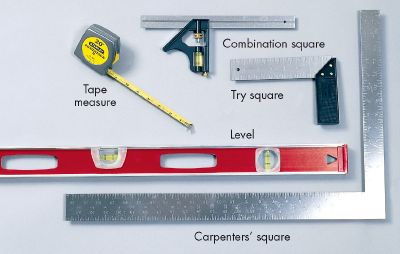
|
Mill Tooth Tricone Bits
Mining Products
MSDS (Material Safety Data Sheets)
Mud Seals
Mud Subs
Mud Valves
Non-toxic Lubricants
Notebooks
Oil, Compressor
Oil, Engine
Oil, Rock Drill
Oil Rig Gloves
Oil Sorbent Pads
Oilers, Automatic - Electric
Oilers, Automatic - Pneumatic
Overburden Systems
Packers, Gravel
PDC Bits
Percussion Drills
Percussion Hammer Bits
Perforators
Petol Wrenches
Pipe, Drill
| |
Pipe fitting
|
| |
Pipe Threading
|
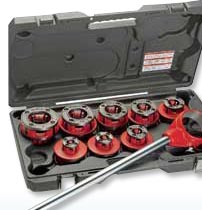
| |
Picks, Rock | |
Pipe Inspection Equipment | 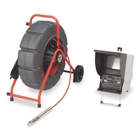 | |
Pipe Locators | 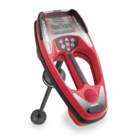 | |
Pipe Threader |

|
Pipe Beveling and Cutting Machines
Pipe Centralization System
Pipe Dope
Pipe Dope Brushes
Pipe Spinners
Pipe Wipers
Pipe Wrenches
Pipe Wrench Parts | |
Plumbing fixtures
|
Bathtubs
Bidets
Channel drains (also called trench drains)
Drinking fountains
Hose bibbs (connections for water hoses)
Kitchen sinks
Lavatories (also called bathroom sinks)
Showers
Tapware - an industry term for that sub-category of plumbing fixtures consisting of tap valves, also called water taps (British English) or faucets (American English), and their accessories, such as water spouts and shower heads.
Terminal valves for dishwashers, ice makers, humidifiers, etc.
Urinals
Utility sinks
Water closets (WC) (known as toilets in the USA, loos, flush toilets or lavatories in Britain)
Outlets and drains
Traps and vents
Drains
Electronic plumbing
Garbage disposer
|
Plugs, Drill Hole
Plugs, Lifting
Pneumatic Drills / Breakers / Hammers
Pneumatic Oilers
Polymers
Portable Air
Portable Decking
Portable Power, Solar
Portable Water Tanks
Post Equipment, Hydraulic
Power Pole Drills
Probes, Well
Pullers, Casing, Hydraulic
Pullers, PVC Casing
Pump Columns
Pumps, Drain, Hydraulic
PVC Casing
PVC Casing Elevators
PVC Casing Pullers
R & O Lube ES
Raise Boring
RDO 302 ES (MW)
Reamers
Refinery Wrenches
Rental Items
Retract Hammers
Reverse Circulation Back Reamers
Reverse Circulation Drill Bits
Reverse Circulation Drill Pipe
Reverse Circulation Hammers
Reverse Circulation Lift Tubes
Ridgid Pipe Wrenches
"Rite In The Rain" Products
Rock Bits
Rock Chisels
Rock Drill Oil
Rock Drills
Rock Picks
Rod Grease
Rod Grease - Non-metal
Rod Wipers
Rod, Drill
Rotary Bits
RP 2000 ES
Safety Cables, Air Hose - Whip Sock
Safety Cables, Air Hose
Safety Gloves
Sample Bags
Sample Bag Supplies
Santori Tubes
Saws, Cut-off, Hydraulic, Handheld
Seismic 2 in 1
Seals, Diverter Box
Seals, Mud
Seal-O-Grip
Shale Traps
Shank Adapters
Sharpeners
Shock Absorbers
Shoes, Casing Drive
Sieves
Side Inlet Swivels
Slings, Lifting
Slips, Casing
Slo-Freeze ES
Sol-Lube ES
Solar, Portable Power
Spinners, Casing
Spinners, Drill Pipe
Splitters, Wet
Stabilizers, Drill Pipe
Stabilizer Fluids
Steel Casing
Steel, Drill | |
Stainless Steel
Sink w/Faucet
|
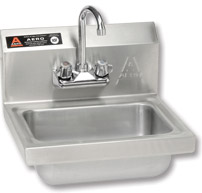
|
Step Bits
Stones, Grinding
Stratex Accessories
Stratex Products
Stratex Centro System
Stratex Drop-off Ring System
Stratex Eccentric System
Stripper Rubbers
Subs
Subs, Air Bypass
Subs, Hydrocyclone
Subs, Shock
Suckerod Elevators and Transfers
Surfactant (Foamer)
Swivels
Symmetrix Under Reamer Systems
Systems, Drilling
Tapered Drill Steel Equipment
Tanks, Water, Portable
Thread Adapters
Thread Grease
Thread Protectors
Tong, Chain
Tongs, Breakout, Hydraulic
TopHammer Equipment - Atlas Copco
Torch Guides
Torqueless
| |
Toilet |
Flush toilet
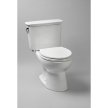
Squat toilets
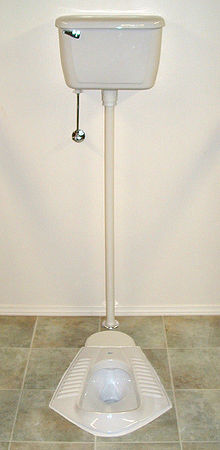
http://www.plumbingsupply.com/
|
Transfers, Suckerod
Traps, Shale
Tricone Bits
Tubes, Exhaust
Turbine Fluid, Line Shaft ES
Ultra Vis
Under Reamer Systems
Underwater Cameras
Utility Power Pole Drills
Valves, Float
Vibra-Stop
Viscosifiers
Water Tanks, Portable | |
Water Cooler
|
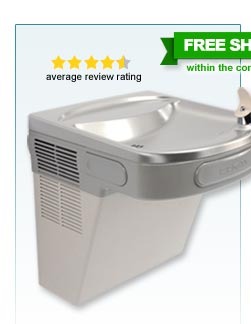
|
Welding Clamps
Well Cameras
Well Casing
Well Packers
Well Pipe Clamps
Well Probes
Well Supplies
Wet Splitters
Whip Checks - Whip Sock
Whip Checks
Wire Rope Lube ES
Wipers, Rubber
Work Gloves
Wrenches, Chain
Wrenches, Flange | |
Wrenches Pipe |
Pipe Wrench
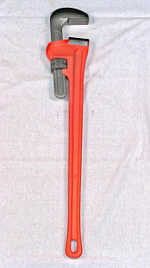

60" heavy duty straight wrench
48" heavy duty straight wrench
36" heavy duty straight wrench
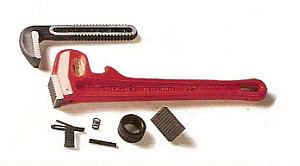
Pipe Wrench Parts
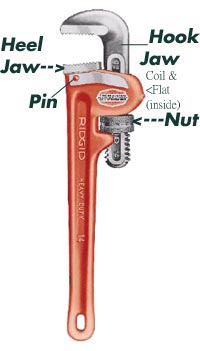
| |
Wrenches, Refinery
|
|
Drills: Put a hole in any kind of material with the right drill. |
Saws: Quickly cut lumber, plywood, and drywall into the right shape and size with one of these tools.
Which kind of drill should you use?
Power Drill
Whether corded or battery-powered, these drills will give you added speed and power.
Hand Drill
Tape Measure
Length, width, and height are at your fingertips with this helpful strip of inches and centimeters.
Square
For straight edges and right angles, a square is a helpful device.
Level
The tiny bubbles in a level will help you to keep objects truly horizontal and vertical.
Chalk Line
A pluck of the string will give you a puff of chalk and an instant straight line.
Stud Finder
Though studs are hidden behind the wall, this device can track them down for you.
Materials:
How much material do you need?
Do you need a material that's malleable or sturdy?
Can it be a natural substance?
Plumbing Supplies
Drain Problems
Bathroom Problems
Heating Problems
Water Heaters
Plumbing and Heating Parts
Plumbing follows the basic laws of nature -- gravity, pressure, water seeking its own level.
The plumbing system in your home is composed of two separate subsystems. One subsystem brings freshwater in, and the other takes wastewater out. The water that comes into your home is under pressure. It enters your home under enough pressure to allow it to travel upstairs, around corners, or wherever else it's needed. As water comes into your home, it passes through a meter that registers the amount you use. The main water shutoff, or stop, valve is typically located close to the meter. In a plumbing emergency, it's vital that you quickly close the main shutoff valve. Otherwise, when a pipe bursts, it can flood your house in no time. If the emergency is confined to a sink, tub, or toilet, however, you may not want to turn off your entire water supply. Therefore, most fixtures should have individual stop valves.
Water from the main supply is immediately ready for your cold water needs. The hot water supply, however, requires another step. One pipe carries water from the cold water system to your water heater. From the heater, a hot water line carries the heated water to all the fixtures, out-lets, and appliances that require hot water. A thermostat on the heater maintains the temperature you select by turning the device's heating elements on and off as required. The normal temperature setting for a home water heater is between 140 degrees F and 160 degrees F, but 120 degrees F is usually adequate and is also more economical. Some automatic dishwashers require higher temperature water, though many of these have a water heater within them that boosts the temperature another 20 degrees F.
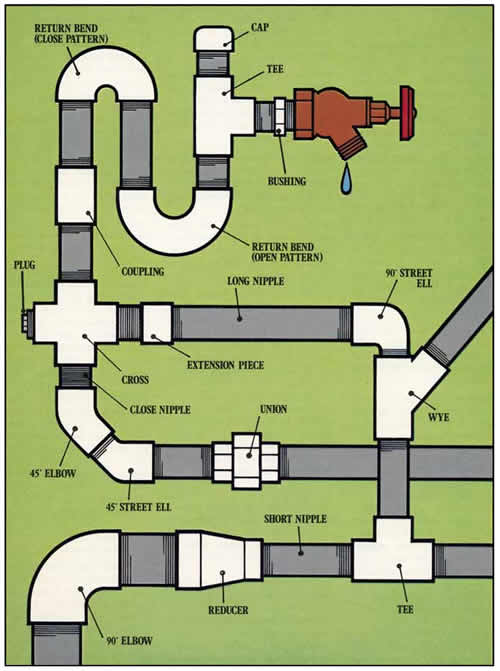
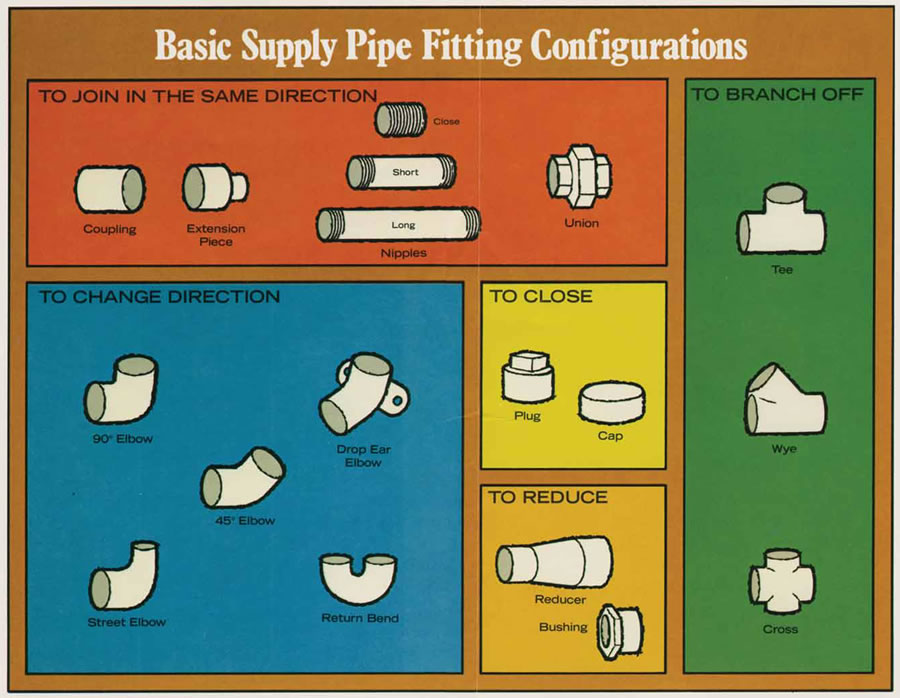
Spanner
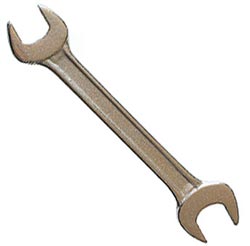
Adjustable spanner
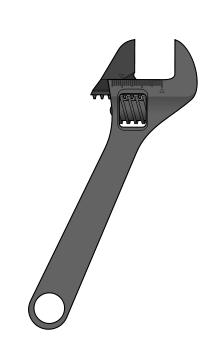
An adjustable spanner or adjustable wrench is a spanner (wrench) with a "jaw" of adjustable width, allowing it to be used with different sizes of fastener head (nut, bolt, etc) rather than just one faster, as with a conventional fixed spanner. An adjustable spanner may also be called a shifting spanner, shifter, fit-all, crescent wrench or adjustable-angle head wrench.
Cast Iron Pipe Fittings
Galvanized Pipe Fittings
Brass Pipe Fittings
PVC Pipe Fittings
HDPE Pipe Fittings
ABS Pipe Fittings
Copper Pipe Fittings
|
Faucets
* Bathroom Faucets
* Kitchen Faucets
* Bathroom Sinks
* Kitchen Sinks
* Bathroom Sink Faucets
* Vintage Baths
* Shower Faucets
|
* Flush toilet
* Squat toilet
* Urinal
o Wall-hung urinal
o Floor-length urinal
o Gutter type urinal
o Female urinal

|

It's easy to take a toilet for granted--at least until something goes wrong with it. But when a toilet threatens to overflow, runs incessantly, or leaks onto the floor, we gain a full appreciation of what it means to have it working properly.
This site, Toilet-Repairs.com, is a one-stop resource for free, expert advice about toilet repair and care. We'll help you handle your own repairs or point you to qualified local pros when the job is beyond your reach.
Many toilet repairs can be surprisingly quick and easy for do-it-yourselfers--and doing your own repairs often makes sense, for a couple of reasons: 1) You can save the $80 or more per hour that a plumber would cost, and 2) you can take care of the problem immediately, without waiting for a plumber to arrive. To handle many basic toilet repairs, you just need a few tools, such as a toilet plunger, pliers, screwdriver, and wrench.
Before you begin, it's important to become familiar with the basic workings of a toilet.
How a Toilet Works & Toilet Plumbing Diagrams
The simple but ingenious mechanics of the toilet have changed very little since the earliest "water closet" was invented in the 19th century.
toilet plumbing diagramThe toilet, though not one of the more glamorous of home fixtures, is designed to do a very specific job--to carry away waste and prevent sewer gases from entering the house. And unless something goes wrong with a toilet, it handles its job adroitly.
As shown in the illustrations at right and below, a toilet has two main parts, both made from vitreous china: a tank and a bowl. Some toilets are cast as a single piece while others are made in two separate parts that are joined together.
The tank, which houses all of the working parts, is where various types of toilets differ the most. Several different kinds of mechanisms may be used to accomplish a toilet's basic operation. Following is a description of how the most common mechanism works:
When a toilet is ready for use, both tank and bowl are partly filled with water. Passages between the bowl and the closet bend form a trap that remains filled with water at all times, blocking the rise of sewer gases.v
When you flush the trip lever, it lifts a rubber stopper--called a tank ball, flush valve seat ball, or the newer, more effective, flapper or flapper ball--from the flush valve, letting the water in the tank flow into the bowl.
The pressure of the cascading water forces the bowl's water and waste down the waste pipe. The water flowing into the bowl also cleans the bowl. The bowl's water is replenished by water entering from the tank through a supply tube that connects to the home's cold water supply piping.
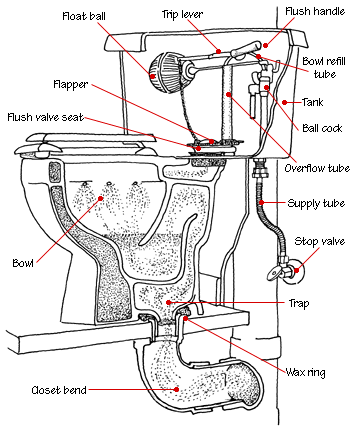
The flush valve and the flapper together are called--not surprisingly--the flapper valve. A flush valve is 2 1/2 inches in diameter, as is the ball-shaped part of the flapper. The flapper hinges onto the vertical overflow pipe that's next to the valve, and a small chain connects the flapper to the trip lever.
The advantage of a flapper over the earlier stoppers is that it doesn't have as many parts to foul or get hung up, so it's less likely to let the tank "run" or leak into the bowl.
As the tank of a conventional toilet empties, a float ball drops, activating the ball cock (simply a water valve), which releases water into the tank. Some new ball cocks operate on water pressure--they don't have a float ball.
The water is delivered to the ball cock through the previously mentioned supply tube, which is connected to a valve at the wall or floor. This valve goes by various names, including stop valve, supply valve, and shutoff valve. When turned clockwise, this valve shuts off the flow of water to the tank. To prevent overflow and flooding, the top of the overflow tube is open and acts as a drain if the tank's water level rises too high.
In today's water-conserving toilets, a minimum-flush mechanism seals the flush valve seat when the tank is still partially full, keeping full pressure on the flush but using less water. A pressurized cylinder inside the toilet tank cuts water usage by putting a small amount of flush water under pressure--either from compressed air or toilet float ball cock partsfrom the house supply line's water pressure. A pressure-activated ball cock is activated by a drop in the tank's water pressure. This type, easily adjusted to deliver various amounts of water to the tank, eliminates the need for a float.
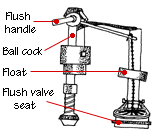
The conventional float-ball, lift-wire, and tank-ball mechanism has been the standard flushing device for many years. The cut-away view above shows the relationship of the tank to the bowl and how the toilet's base forms a trap to block sewer gases. The flush handle raises the trip lever, raising the flush valve or seat ball from the flush valve seat, letting water rush into the bowl.
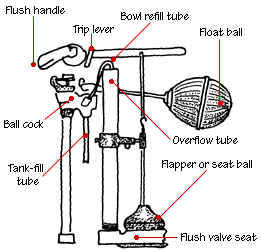

The illustration at left shows a typical flapper combined with a pressure-activated ball-cock valve. The illustration at right shows the older style of float ball with a standard ball cock. When the float ball drops, the ball cock opens, filling the tank until the ball floats back into its upper position. The overflow tube sends excess tank water to the bowl. The refill tube replenishes water in the tank through the overflow tube.
How to Fix a Clogged Toilet
How to Repair a Running Toilet
How to Repair Toilet Leaks
How to Repair Toilet Flushing Problems
How to Repair a Sweating Toilet
How to Replace a Toilet Wax Ring | |
| |
Aerospace Fasteners
|
1. What does a plumber do?
2. What are some health and safety issues for plumbers?
3. What are some preventive measures for plumbers?
4. What are some good general safe work practices?
5. Where can I get more information?
6. What kind of work are plumbers responsible for?
7. What mechanical systems and equipment do they repair?
8. Which tools and equipment do they require?
9. What tools are not available?
10. What training do plumbers need?
How long have you been a plumber?
Were you formally trained or did you learn through an apprenticeship?
Do you belong to any professional associations?
Do you have any references I can contact?
Having some plumbing problems?
Questions about Your Plumber's Work
Do you give written warranties?
Will this project require a permit?
Can you estimate how long this will take?
Will you provide options for different materials?
Interview Question for References
Were you happy with the project?
Was the job completed on time?
Were there any unexpected expenses?
Would you use this plumber again?
Would you recommend this plumber?
What does a plumber do?
A plumber is a person who installs, repairs and maintains plumbing fixtures or systems in businesses, industries or residences.
The main duties of a plumber are to:
Bending/Forming
Brushes
Drain Cleaning
Other Accessories
Pipe/Tube Cutting
Repair/Joining
Threading
* Measure, cut, shape, assemble and join various materials
* Use, clean and maintain various equipment
* Read, prepare or interpret blueprints and drawings
* Conform with building codes and other regulations
* Prepare cost estimates and documentation for clients
* Supervise apprentices or other workers
What does a plumber do?
* Install bathroom suites
* Fit hand basin
* Re-Seal baths and showers
* Install WC
* Repair leaks
* Replace taps
* Repair burst pipes
Replace old piping
* Fit toilet seats
* Clear blocked toilets
* Repair toilets
* Fix tap washers
* Repair overlow problems
Unclog a toilet
* Install outside tap
* Install washing machines
* Install dishwashers
* Fit radiators
* Fit combi-boiler showers
* Install shower cubicles
* Re-silicone bath or shower
When a new building is being constructed, a plumber is typically part of the construction crew. He or she determines where pipes should be laid, and takes care of the installation of these pipes. The plumber also typically connects the internal plumbing to external fixtures like sinks, showers, and washing machines.
What are some health and safety issues for plumbers?
Plumbers work in a variety of settings, some of which may contain hazards. The main occupational hazards for plumbers to be aware of include:
* Potential infection from bird or rodent droppings
o histoplasmosis
o psittacosis
o hantavirus
* Exposure to lead, adhesives, solvents, solder, sulphur dioxide, and other toxic or carcinogenic substances
* Proximity to flammable or combustible materials
* Working in awkward positions, or performing awkward manual tasks
* Lifting heavy or awkward objects
* Exposure to extreme temperatures
* Working in confined spaces
* Working at heights
* Risk of eye injury from flying particles
* Slips, trips and falls
* Working with various tools
* Stress
* Shift work or extended work days
What are some preventive measures for plumbers?
* Follow safety procedures for confined space entry, trenches and excavations.
* Use fall protection and other precautions when working at heights.
* Install and maintain good ventilation.
* Keep tools and equipment, and their safety features, in good working order.
* Use appropriate personal protective equipment for the task.
* Wear appropriate footwear.
* Keep work areas clear of clutter and equipment.
* Avoid awkward body positions and repetitive manual tasks, or take frequent breaks.
* Learn safe lifting techniques.
* Follow a recommended shift work pattern, and know the associated hazards.
What are some good general safe work practices?
* Practices safety procedures for:
o Confined space entry
o Working at heights
o Working with hand tools, and power tools
o Selection, use and maintenance of personal protective equipment
o Selection of footwear
o Lifting
o Shift work
* Follow company safety rules.
* Learn about chemical hazards, WHMIS and MSDSs.
* Know how to report a hazard
* Follow good housekeeping procedures.
Where can I get more information?
Engineering and maintenance managers know that plumbing operations rely on an arsenal of tools and equipment — from wrenches and pipe cutters to valve repair kits and spare parts — to respond efficiently to both large and small tasks.
So it is vital that plumbers have the right combination of tools and equipment and the latest technology and materials. Answering these five questions will help managers plan for tool upgrade needs:
1. What kind of work are plumbers responsible for?
2. What mechanical systems and equipment do they repair?
3. Which tools and equipment do they require?
4. What tools are not available?
5. What training do plumbers need?
Plumbing Duties
Managers can review job descriptions to determine primary responsibilities and duties performed. If these descriptions are obsolete, ask the incumbents for their actual duties. Some plumbers do only minor repairs to plumbing fixtures and hot- and cold-water and drain systems. Major mechanical repairs, such as boiler tube and pop-valve repair, or rebuilding a compressor, are done by pipe fitters or outsourced.
If a particular task doesn’t occur very often, it won’t pay to keep skills on hand and tools and parts in stock. Even so, list all this work. Later, sort out which work will be outsourced, such as pop-valve refurbishing and testing, and put it on a contractor list.
Mechanical systems that usually are the responsibility of plumbers and pipe fitters are: hot- and cold-water lines and restroom fixtures; steam lines; HVAC systems; compressors and pressurized air-distribution systems; gas valves and lines; sprinkler pumps, valves and piping systems; vents, drain lines and sewer systems; condensate return lines; and boiler systems.
In-place Systems
Managers will need to visually check all mechanical systems to determine the required tools and equipment. Some piping disappears inside walls, above ceilings, under floors or underground. If they are not visible, managers can identify hidden items from the building mechanical system drawings prepared by the engineers before construction. The drawings show the location of the runs and equipment, bills of material containing type of material, size of items, and specific mechanical equipment details to help define tool needs.
Managers should double-check work sites where possible. Such checks can reveal changes made since the original installation. Mark the changes on the original drawings. Additional sources of information are operations and maintenance catalogs for mechanical system equipment, such as boilers, pumps, compressors, chillers, fans and blowers. They contain more detail about construction and spare parts.
By tracing each system in the scope of work, managers identify the type of installed equipment. For each major system, managers will need to consider the material, the size of piping and the types of fittings and joints in order to determine the tools technicians will need for disassembly, repair and assembly.
Managers also will need to note the type of material — copper, stainless steel, malleable iron, cast iron, plastic, cement, and tile. The size of piping determines the size of tools to be used, such as cut-off saws, threaders, dies, taps, and pipe wrenches. Also, managers will need to check fitting and valve specifications of gate, globe and ball valves; slip-on flanges; and threaded, welded, glued or soil pipes.
Tools and Equipment
The hardest part of plumbing work is removing old pipes and fittings. Threaded joints on schedule 40 black iron steam pipe often are seized and require several shots of liquid wrench, some tapping with a ball peen hammer, two very large pipe wrenches or an impact hammer, and two pipe fitters to loosen the rusted or encrusted material.
Pairs of various-sized pipe wrenches aid disassembly, and a putty knife and stiff wire brush cleans threads and flanges. Fitters need some joint compound or Teflon tape, compound brush, replacement fittings and pipe, and pipe wrenches for assembly.
Anti-seize compound is a must for steam fittings to avoid disassembly problems in the future. Copper hot- and cold-water lines with sweat joints require a pipe cutter or saw, a torch, flux and solder. Emery cloth removes oxidation and polishes the copper surface before soldering.
A tube cutter cuts out small-diameter sections of pipe, and a torch and a wire brush loosens old solder. Where compression fittings and copper pipe are used, workers will need liquid wrench and a ball-peen hammer to close difficult to-turn fixture valves to isolate the work site, and also a wrench- handle extension to reach into difficult-to-access locations.
Plumbers also need a pair of the properly-sized open-end wrenches and thread compound for compression fitting nuts. Also, if fittings are hard to reach — for example, water faucet nuts that hold the faucet in place under a sink — they will need a special faucet nut wrench. These special wrenches are sometimes the only way to get leverage to turn the nuts in places where access was limited.
If systems use flared fittings, plumbers will need a tool to flare the end of the copper pipe after the nut is slid on, as well as a tubing cutter to cut pipe to length. Or they can use braided flexible stainless-steel hose with compression nuts already attached, which is more expensive material but results in lower labor cost.
For clogged drains, plumbers need a range of tools, from the standard plunger and manual router, or snake, to an electric-powered router or pressurized water pig for large pipelines. Long lines might require inspection by video camera to guard against intrusion by tree roots or broken pipe walls, due to age or heavy equipment pressure.
For pump repair, depending on the type and size, plumbers will need:
* open-end wrenches
* packing tools to replace the packing
* ratchet wrenches
* sockets
* allen wrenches to remove the coupling, casing, bearings or rotating element
* a gasket cutter for split-case pumps
* a lathe to turn packing sleeves
* brazing equipment for impeller buildup and leak repair
* a lathe to finish turn the impeller and packing sleeves
* balancing wheels for final balancing of the impeller and rotating element
* calipers, dial indicator, feeler gauges or laser alignment tools for aligning the rotating assembly and coupling during re-assembly.
A vibration analyzer is an excellent predictive tool for rotating equipment, particularly pumps. An analyzer predicts failure and zeroes in on causes before failure occurs. An analyzer expands the shop’s predictive maintenance capability and improves system reliability.
Fitters use liquid wrench to loosen black-iron pipe and fittings, plus a ball- peen hammer and a pair of pipe wrenches. Copper-control lines require open-end wrenches to disassemble and assemble fittings, oilers, and lubricators, as well as very small open-end wrenches for disassembling control relays in instruments to clean the parts and prevent sticking during operation.
A non-contact infrared thermometer is excellent for on-line inspection of steam traps and other heat-emitting equipment, such as heat exchangers. The technician stands several feet away from the heat source and measures its temperature, comparing it with the normal temperature.
For example, a cold bucket in a steam trap means condensate is backing up in the pipeline. Scheduled trap and strainer cleaning or replacing a corroded mechanical bucket and flapper solves the problem, reducing energy cost. If several plumbers need the instrument, managers can add another one to the list. Infrared thermometers also can be used to check electrical equipment and controls, so they would get plenty of use.
Additional Tools
Managers should carefully review the list of tools and requisition needed tools to fill in any discovered gaps. Managers can tailor their purchases based on plumbers’ actual job duties. For example, if plumbers are not expected to work on pipe more than 6 inches inside diameter, don’t order any material or tools for that type of work.
Likewise, if workers will not do welding more than once or twice a year, don’t bother to purchase welding rods of various sizes, as well as metals, grinders, weld clamps, welding hood, goggles, gloves, jackets, cables or oxygen and acetylene. Instead, managers can decide to outsource welding tasks as needed.
It pays to buy top-quality tools when specifying tools. Most quality hand tools have lifetime guarantees, so they are replaced free if they are broken during normal use. Normal use, of course, doesn’t include putting a 4-foot extension pipe on a 36 pipe wrench to get more leverage when a 60 pipe wrench is really needed.
Training
Include all the manuals and vendor training in the requisition. The vendor knows safety requirements and all sorts of shortcuts, special tips and tricks that help will plumbers perform the tasks more safely, better and more quickly.
Make sure plumbers understand recent plumbing code changes. Some non-code situations might have been in place for a long time.
Those non-code systems resulted from many causes, whether poor design, or poor or incomplete installation during construction, such as a single trap for a bank of three heating coils instead of one trap for each coil. Or modifications were made in the code after the building or the addition was built.
Training on plumbing codes and changes can help plumbers correct these situations to improve system efficiency and bring systems up to code.
|
|

